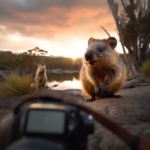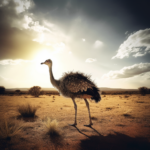Quokka vs Marmot: A Comparison of Two Adorable Creatures
Quokkas and marmots are two fascinating creatures that have captured the hearts of animal lovers around the world. Both species are known for their adorable appearance and unique behaviors. In this article, we will delve into the characteristics and habits of quokkas and marmots, highlighting the similarities and differences between these lovable animals. Whether you’re a nature enthusiast or simply curious about these delightful creatures, join us on this journey to discover more about the quokka and the marmot. So, let’s dive in and explore the world of these charming creatures!
Key Takeaways
- Quokkas and marmots are both small mammals, but they belong to different families and are found in different parts of the world.
- Quokkas are native to Australia, particularly found in Western Australia, while marmots are found in various parts of North America, Europe, and Asia.
- Quokkas are known for their friendly and curious nature, often referred to as the “happiest animal on Earth,” while marmots are known for their social behavior and loud warning calls.
- Quokkas have a rounder face with a short snout, while marmots have a more elongated face with a longer snout.
- Both quokkas and marmots are herbivores, but their diets may vary slightly depending on their habitat.
- Quokkas are listed as a vulnerable species, primarily due to habitat loss and predation, while marmots are not currently considered endangered.
- Quokkas have gained popularity due to their photogenic appearance and the rise of social media, while marmots are often associated with alpine environments and hiking destinations.
Understanding Quokkas and Marmots: A Comparative Overview
A. What is a Quokka?
Quokkas are small marsupials native to the southwestern part of Australia. They belong to the same family as kangaroos and wallabies, known as the macropods. Quokkas are often referred to as the “happiest animals on Earth” due to their friendly and approachable nature. These adorable creatures have become quite popular in recent years, thanks to their photogenic smiles.
Quokka Characteristics
- Quokkas are about the size of a domestic cat, measuring around 16 to 21 inches in length.
- They have a stocky build with short, rounded ears and a small, black nose.
- Their fur is coarse and sandy brown in color, with lighter shades on their undersides.
- Quokkas have strong hind legs, enabling them to hop efficiently.
- Their tails are short and thick, providing balance as they move around.
- One of the most distinctive features of quokkas is their perpetually smiling faces, which is due to the shape of their mouths.
Quokkas primarily inhabit the dense vegetation of the forests and scrublands of Rottnest Island and a few other islands off the coast of Western Australia. They are herbivores, feeding on a variety of plants, grasses, and leaves. Quokkas are known to be excellent climbers and can even swim if necessary.
B. What is a Marmot?
Marmots, on the other hand, are large ground-dwelling rodents that belong to the squirrel family. They are primarily found in North America, Europe, and Asia. Marmots are known for their burrowing habits and are often seen in mountainous regions, where they create complex underground networks of tunnels and chambers.
Marmot Traits
- Marmots vary in size depending on the species, with some being as small as a squirrel and others as large as a small dog.
- They have a robust build with short legs and a long, bushy tail.
- Marmots have sharp claws and powerful incisors, which they use for digging burrows and foraging.
- Their fur can range from brown to gray, providing camouflage in their natural habitats.
- Marmots have a whistle-like alarm call, which they use to alert others of potential threats.
Marmots are herbivores and have a diverse diet that includes grasses, leaves, flowers, and even bark. They are diurnal animals, meaning they are active during the day and spend most of their time outside their burrows. Marmots are highly social creatures and live in colonies, where they engage in various behaviors such as grooming, playing, and communicating through vocalizations and body language.
In conclusion, while both quokkas and marmots are fascinating creatures, they differ in terms of their geographical distribution, physical characteristics, and behaviors. Quokkas are unique to Australia, known for their friendly demeanor and photogenic smiles, while marmots are found in various parts of the world, particularly in mountainous regions. Understanding these differences allows us to appreciate the diversity of wildlife across the globe.
The Natural Habitats: Where Quokkas and Marmots are Found
A. The Unique Home of Quokkas: Quokka Island
Quokkas, known for their adorable smiles, are native to a small island off the coast of Western Australia called Rottnest Island. This island is often referred to as “Quokka Island” due to the large population of these friendly marsupials that call it home. Rottnest Island provides the perfect habitat for quokkas, with its diverse range of vegetation and ample food sources.
The island is characterized by a Mediterranean climate, with warm, dry summers and mild, wet winters. This climate allows for the growth of a variety of plants, including grasses, shrubs, and small trees, which form the primary food source for quokkas. The dense vegetation also provides shelter and protection for these small creatures.
Quokkas are well-adapted to the island‘s environment. They have strong hind legs that allow them to hop around and navigate the rocky terrain with ease. Their sharp claws enable them to climb trees and forage for food. Quokkas are also excellent swimmers and can often be spotted near the island‘s beaches, cooling off in the crystal-clear waters.
B. The Diverse Habitats of Marmots
Unlike quokkas, marmots can be found in various habitats across North America, Europe, and Asia. These burrowing rodents have adapted to a wide range of environments, from alpine meadows to rocky mountain slopes.
In North America, the most common species of marmot is the yellow-bellied marmot, which can be found in the mountainous regions of the western United States and Canada. These marmots prefer habitats with grassy slopes and rocky outcrops, where they can dig their burrows and establish their colonies.
European marmots, such as the Alpine marmot, inhabit the high-altitude regions of the Alps and other mountain ranges. These marmots are well-suited to the harsh alpine environment, with their thick fur and stocky bodies providing insulation against the cold temperatures.
Asian marmots, including the Siberian marmot, are found in the grasslands and steppes of Mongolia, China, and Russia. These marmots have adapted to the vast open spaces, where they can graze on grasses and other vegetation.
Regardless of their specific habitat, marmots are known for their burrowing behavior. They dig extensive underground burrows, which serve as their homes and provide protection from predators and harsh weather conditions. These burrows can have multiple entrances and chambers, allowing marmots to escape quickly if threatened.
In conclusion, while quokkas are confined to the unique habitat of Quokka Island, marmots have a more diverse range of habitats across different continents. Both species have adapted to their respective environments, showcasing their remarkable ability to thrive in various landscapes.
Quokka vs Marmot: A Detailed Comparison
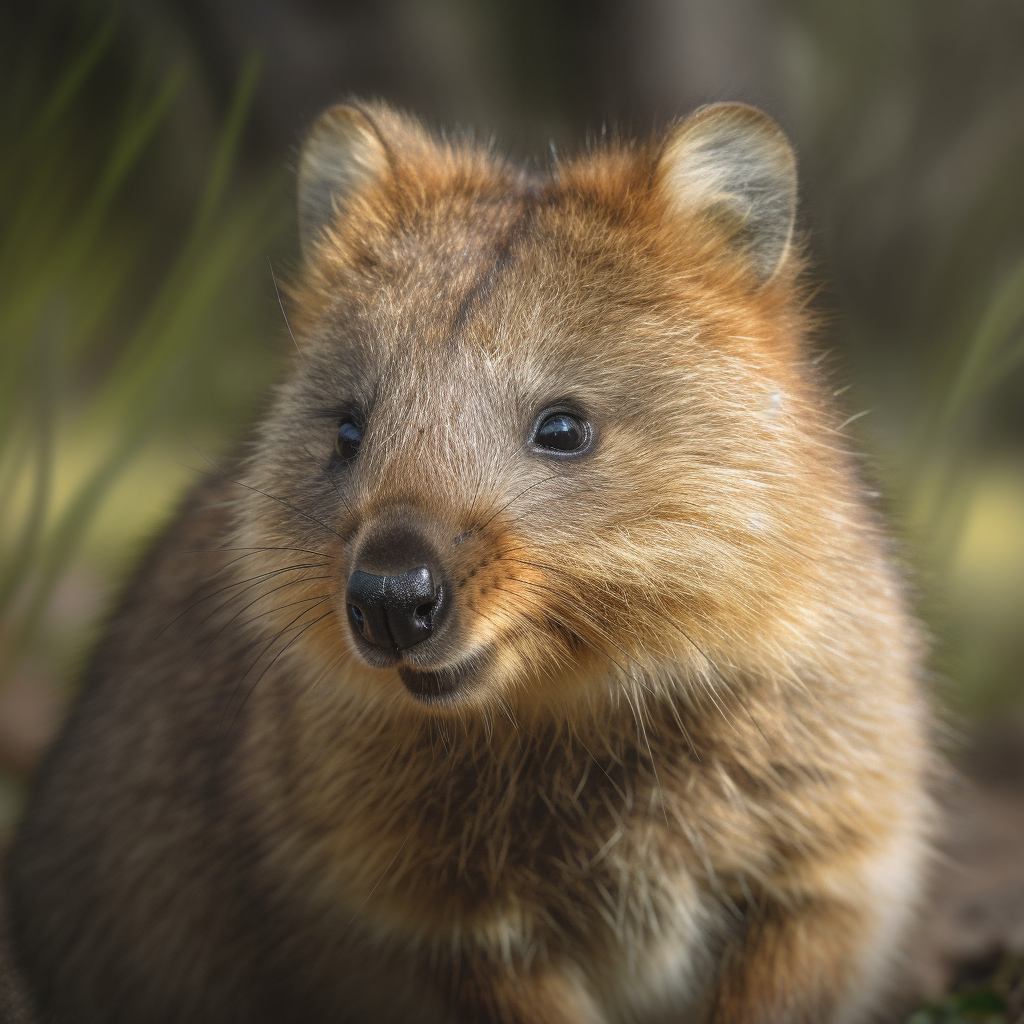
A. Physical Differences: Quokka vs Marmot
When comparing the physical characteristics of the quokka and the marmot, it becomes evident that these two animals have distinct features that set them apart.
Quokka Characteristics
The quokka, also known as the “happiest animal on Earth,” is a small marsupial native to Western Australia. It measures about 40 to 54 centimeters (16 to 21 inches) in length and weighs around 2.5 to 5 kilograms (5.5 to 11 pounds). Quokkas have a round face with a short snout, large dark eyes, and round ears. They have a stocky build and a short, thick tail.
Marmot Traits
On the other hand, marmots are large ground-dwelling rodents found in various parts of North America, Europe, and Asia. They are larger than quokkas, with an average length of 42 to 68 centimeters (17 to 27 inches) and a weight ranging from 2 to 9 kilograms (4.4 to 19.8 pounds). Marmots have a robust body, short legs, and a long bushy tail. Their head is relatively large, with small ears and eyes.
Comparing Quokkas and Marmots
| Physical Characteristics | Quokka | Marmot | |————————–|——–|——–| | Size | Small | Large | | Body Shape | Stocky | Robust | | Tail | Short | Long | | Head | Round | Large | | Ears | Round | Small | | Eyes | Large | Small |
B. Behavioral Traits: Quokka vs Marmot
Apart from their physical differences, quokkas and marmots also exhibit distinct behavioral traits.
Quokka Behavior
Quokkas are known for their friendly and curious nature. They are often seen approaching humans, which has earned them the reputation of being the “world’s happiest animal.” Quokkas are primarily herbivorous, feeding on grasses, leaves, and bark. They are also excellent climbers and can jump up to 1.5 meters (5 feet) in height.
Marmot Behavior
Marmots, on the other hand, are more reserved and cautious. They are highly social animals, living in colonies and communicating through various vocalizations. Marmots are herbivores as well, with a diet consisting mainly of grasses, herbs, and flowers. They are excellent diggers and create complex burrow systems for shelter and hibernation.
C. Survival Strategies: Quokka vs Marmot
Both quokkas and marmots have developed unique survival strategies to thrive in their respective environments.
Quokka Adaptations
Quokkas have adapted to their habitat in Western Australia by developing several survival mechanisms. They have strong hind legs, allowing them to move quickly and escape predators. Quokkas are also capable swimmers, which helps them access different food sources and escape danger. Additionally, their ability to enter a state of torpor during times of food scarcity enables them to conserve energy.
Marmot Adaptations
Marmots have evolved specific adaptations to survive in their habitats as well. Their burrow systems provide protection from predators and harsh weather conditions. Marmots also hibernate during the winter months, reducing their metabolic rate and conserving energy. This adaptation allows them to survive in regions with cold climates and limited food availability.
In conclusion, while quokkas and marmots share some similarities as herbivorous mammals, they have distinct physical characteristics and behavioral traits that differentiate them. Quokkas are small, friendly, and curious marsupials found in Australia, while marmots are larger, more reserved rodents inhabiting various parts of North America, Europe, and Asia. Both animals have adapted to their environments through unique survival strategies, ensuring their continued existence in their respective habitats.
The Fascinating Life of a Quokka
A. The Quokka Baby: An Insight into Their Early Life
Quokkas, native to the beautiful islands of Western Australia, are known for their adorable appearance and friendly demeanor. These small marsupials belong to the same family as kangaroos and wallabies, and their life cycle is just as intriguing.
When a quokka baby, known as a joey, is born, it is only about the size of a jellybean. Like other marsupials, quokkas give birth to relatively undeveloped young. The tiny joey makes its way into its mother’s pouch, where it will spend the next six to seven months of its life.
Inside the pouch, the joey attaches itself to one of the mother’s teats, where it receives nourishment and continues to grow. As it gets older, the joey will gradually venture out of the pouch, exploring the world around it while still returning to the safety and comfort of its mother’s pouch.
During this time, the joey becomes more independent, learning valuable skills such as hopping and foraging for food. It is truly a remarkable sight to witness these tiny creatures taking their first steps into the world.
B. Why Quokkas Smile: Unraveling the Mystery
One of the most captivating aspects of quokkas is their seemingly constant smile. It’s hard not to be charmed by their cheerful expression. But why do quokkas smile?
Contrary to popular belief, quokkas don’t actually smile. The shape of their mouths gives the illusion of a smile, but it’s simply a result of their facial structure. Their mouths naturally curve upwards, creating a perpetually happy appearance.
This unique feature has made quokkas famous for their photogenic qualities. Visitors to Rottnest Island, where a large population of quokkas resides, often take selfies with these adorable creatures, capturing their infectious “smiles” for the world to see.
C. The Unusual Behavior: Why Do Quokkas Throw Their Babies?
While quokkas are generally known for their gentle nature, there is one behavior that has puzzled researchers and wildlife enthusiasts alike – the act of quokkas throwing their babies.
Contrary to its name, this behavior does not involve physically throwing the joey. Instead, it refers to the quokka mother’s action of pushing her joey out of the pouch when it reaches a certain age. This behavior is believed to be a natural instinct to encourage the joey’s independence and prepare it for life outside the pouch.
Once the joey is pushed out, it will spend more time exploring its surroundings, learning essential survival skills, and gradually becoming self-sufficient. This behavior is crucial for the joey’s development and ensures its ability to thrive in the challenging Australian environment.
While it may seem unusual to us, this behavior is a normal part of a quokka’s life cycle. It is a fascinating example of how different species have evolved unique strategies to ensure the survival of their young.
In conclusion, the life of a quokka is filled with intriguing characteristics and behaviors. From the early stages of a joey‘s life inside its mother’s pouch to the mystery behind their perpetual smile and the unusual behavior of pushing their babies out of the pouch, quokkas continue to captivate our curiosity. These delightful creatures are a testament to the diversity and wonder of the animal kingdom.
The Marmot and Its Similarities with Other Animals
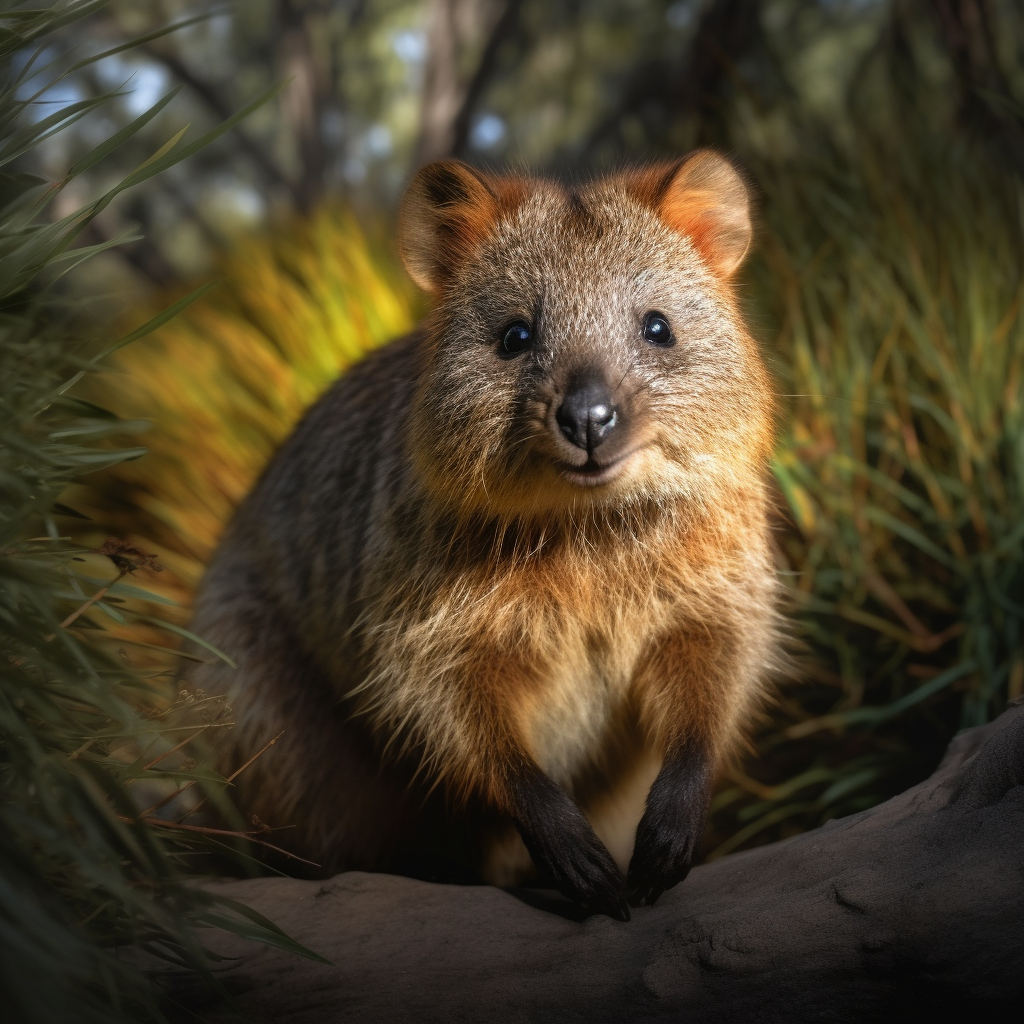
A. Marmot vs Capybara: A Comparative Analysis
When comparing animals, it’s fascinating to discover similarities and differences between species. In this section, we will explore the similarities between the marmot and the capybara, two intriguing creatures that share some interesting characteristics.
Physical Appearance
Both the marmot and the capybara belong to the rodent family, but they differ in size and appearance. The capybara is the largest rodent in the world, weighing up to 150 pounds and measuring around 4 feet in length. On the other hand, the marmot is relatively smaller, with an average weight of 13 pounds and a length of about 2 feet.
Habitat and Distribution
While the capybara is native to South America, specifically the grassy regions near bodies of water, the marmot can be found in various parts of the world, including North America, Europe, and Asia. Marmots are known for their preference for mountainous regions, where they dig burrows and live in colonies.
Social Behavior
Both the marmot and the capybara are social animals, but their social structures differ. Capybaras are highly social creatures that live in large groups, sometimes consisting of over 100 individuals. They are known for their cooperative behavior and often engage in communal activities such as grooming and vocal communication.
Marmots, on the other hand, live in smaller family groups. They are less social compared to capybaras, but they still exhibit some level of social interaction within their colonies. Marmots communicate using a variety of vocalizations and body postures to convey messages to their group members.
B. Marmot vs Cavia: Spotting the Differences
In this section, we will explore the differences between the marmot and the cavia, commonly known as the guinea pig. While both animals belong to the rodent family, they have distinct characteristics that set them apart.
Size and Appearance
One of the most noticeable differences between the marmot and the cavia is their size. Marmots are larger, with a stocky build and a bushy tail. On the other hand, cavias are smaller and have a compact body with a short tail.
Habitat and Behavior
Marmots are typically found in mountainous regions, where they dig burrows and hibernate during the winter months. They are well-adapted to their alpine environments and are known for their ability to survive in harsh conditions.
Cavias, on the other hand, are native to South America and are often kept as pets. They are social animals that thrive in groups and require a comfortable living environment with plenty of space to roam and explore.
Diet and Feeding Habits
Marmots are herbivores and primarily feed on grasses, herbs, and other plant materials. They spend a significant amount of time foraging for food to sustain themselves and their colonies. In contrast, cavias have a more varied diet that includes grasses, vegetables, and fruits. They also require a constant supply of fresh water to stay hydrated.
In conclusion, while the marmot shares some similarities with other animals such as the capybara and the cavia, it also possesses unique traits that make it a distinct species. Understanding these similarities and differences helps us appreciate the diversity of the animal kingdom and the fascinating adaptations that allow each species to thrive in their respective habitats.
Quokkas and Their Relations with Other Animals
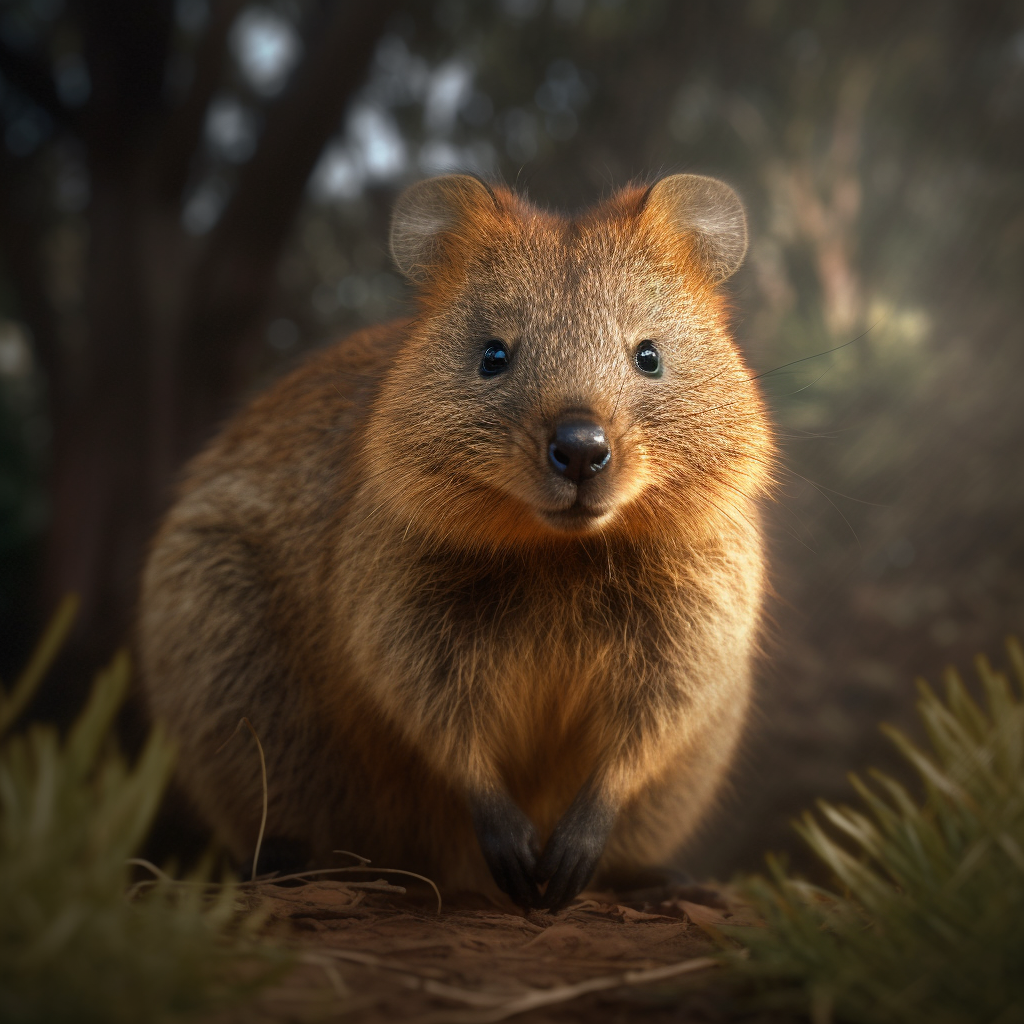
A. Quokka vs Kangaroo: A Comparative Study
When it comes to the unique and fascinating wildlife of Australia, two animals that often capture the attention of visitors are the quokka and the kangaroo. While both belong to the marsupial family, they have distinct characteristics and behaviors that set them apart.
Quokka Characteristics:
- Quokkas are small marsupials, measuring about 40 to 54 centimeters in length.
- They have a stocky build, with round faces and short, rounded ears.
- Quokkas are known for their friendly and approachable nature, often referred to as the “happiest animal on Earth.”
- They have a herbivorous diet, feeding on grasses, leaves, and other vegetation.
- Quokkas are primarily found on Rottnest Island, just off the coast of Western Australia.
Kangaroo Traits:
- Kangaroos, on the other hand, are much larger than quokkas, with adult males reaching heights of up to 2 meters.
- They have long, powerful hind legs and a muscular tail, which they use for balance and propulsion.
- Kangaroos are herbivores, grazing on grasses and shrubs.
- They are found throughout Australia, in a variety of habitats ranging from grasslands to forests.
While both quokkas and kangaroos are herbivores, their diets differ slightly. Quokkas primarily feed on low-lying vegetation, while kangaroos are capable of reaching higher branches and leaves. Additionally, kangaroos have evolved to be excellent jumpers, using their powerful hind legs to cover large distances in a single bound. Quokkas, on the other hand, are not known for their jumping abilities and rely more on their agility and climbing skills.
B. Wombat vs Quokka: Understanding the Differences
Another interesting comparison can be made between the quokka and the wombat, two iconic Australian animals that share some similarities but also have notable differences.
Quokka Behavior:
- Quokkas are known for their friendly and curious nature, often approaching humans without fear.
- They are primarily nocturnal, spending their days resting in shaded areas and becoming more active at night.
- Quokkas are excellent climbers and can navigate trees and shrubs with ease.
- They are also known for their ability to swim, often found near water sources on Rottnest Island.
Wombat Behavior:
- Wombats, on the other hand, are more solitary and less social than quokkas.
- They are primarily nocturnal but can also be active during the day, especially in cooler weather.
- Wombats are excellent diggers, creating complex burrow systems that provide shelter and protection.
- They are not known for their climbing or swimming abilities.
In terms of physical appearance, wombats have a stout and muscular build, with short legs and a broad head. They are well-adapted for digging, with strong claws and powerful shoulders. Quokkas, on the other hand, have a more compact and rounded body shape, with shorter legs and a smaller head.
Overall, while quokkas and wombats are both unique and fascinating animals, they have distinct behaviors and adaptations that allow them to thrive in their respective habitats. Whether it’s the friendly and approachable nature of the quokka or the solitary and burrowing habits of the wombat, these Australian creatures continue to captivate and intrigue wildlife enthusiasts from around the world.
The Quokka: The Happiest Animal in the World
A. Why Quokka is Considered the Happiest Animal
When it comes to happiness, the quokka takes the crown as the happiest animal in the world. These small marsupials, native to Western Australia, have gained quite a reputation for their cheerful demeanor and contagious smiles. But what exactly makes the quokka so happy?
One reason behind the quokka’s happiness is its natural disposition. Quokkas are known for their friendly and sociable nature, often approaching humans without fear. They have a curious and playful personality, making them a delight to interact with. Their constant smile, caused by the unique shape of their mouths, adds to their overall cheerful appearance.
Another factor contributing to the quokka’s happiness is its idyllic habitat. Quokkas inhabit small islands off the coast of Western Australia, where they have minimal natural predators and abundant food sources. This peaceful environment allows them to thrive and live a relatively stress-free life.
Furthermore, the quokka’s diet plays a role in its happiness. These herbivorous creatures primarily feed on grasses, leaves, and shrubs, providing them with a nutritious and balanced diet. Their ability to find food easily contributes to their overall contentment.
B. The Impact of Quokka’s Happiness on Its Survival
The quokka‘s happiness is not just a matter of aesthetics; it plays a crucial role in its survival. A happy quokka is more likely to engage in social interactions, which is essential for finding mates and ensuring successful reproduction. Their friendly nature and willingness to approach humans have also made them popular subjects for wildlife photography, raising awareness about their conservation needs.
The quokka‘s happiness also affects its behavior and ability to adapt to its environment. A content quokka is more likely to explore its surroundings, expanding its knowledge of available resources and potential threats. This adaptability increases its chances of survival, especially in the face of changing environmental conditions.
Additionally, the quokka’s happy demeanor attracts tourists and visitors to the regions where they reside. This influx of tourism contributes to the local economy and supports conservation efforts. The attention and admiration garnered by the quokka help raise awareness about the importance of protecting their natural habitat and ensuring their long-term survival.
In conclusion, the quokka’s reputation as the happiest animal in the world is well-deserved. Their friendly nature, idyllic habitat, and balanced diet all contribute to their overall happiness. This happiness, in turn, plays a vital role in their survival and conservation. So, if you ever have the chance to encounter a quokka, take a moment to appreciate their infectious smiles and remember the importance of preserving their happiness for generations to come.
The Value of Quokkas: How Much is a Quokka Worth?
A. The Monetary Value of a Quokka
When it comes to determining the monetary value of a quokka, it’s important to note that these adorable creatures are protected by law in their native Australia. This means that it is illegal to buy or sell quokkas as pets or for any other commercial purposes. The Australian government recognizes the importance of preserving the quokka population and ensuring their survival in the wild.
However, despite their protected status, quokkas do hold significant value in terms of tourism. The quokka‘s friendly and photogenic nature has made it an internet sensation, attracting visitors from all over the world to Rottnest Island, one of the few places where quokkas can be found. Tourists flock to the island to catch a glimpse of these charismatic marsupials and take selfies with them.
The tourism industry on Rottnest Island has experienced a boost in recent years, thanks to the quokka’s popularity. Local businesses have capitalized on this by offering quokka-themed merchandise, guided tours, and even quokka selfie stations. This surge in tourism has not only benefited the local economy but has also raised awareness about the importance of conservation and the need to protect these unique creatures.
B. The Ecological Value of Quokkas
While it may be difficult to put a monetary value on quokkas, their ecological value cannot be overstated. Quokkas play a crucial role in their ecosystem as seed dispersers. They consume a variety of plant material, including fruits, seeds, and leaves, and help in the distribution of seeds through their droppings.
Quokkas are also important prey for predators such as snakes and birds of prey. Their presence in the food chain helps maintain a balanced ecosystem. Additionally, their grazing behavior helps control vegetation growth, preventing the dominance of certain plant species and promoting biodiversity.
Furthermore, quokkas are considered an indicator species, meaning their presence or absence can indicate the overall health of an ecosystem. Their population size and distribution can provide valuable insights into the state of the environment and the impact of human activities.
In comparison to marmots, which are found in North America, quokkas have a unique role to play in the Australian ecosystem. Marmots, on the other hand, have their own ecological significance in their native habitats. Understanding the ecological value of both species is crucial for conservation efforts and maintaining the delicate balance of their respective ecosystems.
In conclusion, while quokkas may not have a direct monetary value, their worth lies in their contribution to the tourism industry and their ecological significance. Protecting and preserving these charismatic marsupials is not only important for their own survival but also for the overall health and biodiversity of their ecosystems.
Conclusion
In conclusion, both quokkas and marmots are fascinating creatures that inhabit different parts of the world. Quokkas are small marsupials found primarily on Rottnest Island in Western Australia, while marmots are large ground-dwelling rodents found in various mountainous regions across the globe.
While quokkas are known for their friendly and approachable nature, marmots are more reserved and tend to be wary of humans. Quokkas have gained popularity due to their adorable appearance and the viral “quokka selfie” trend, whereas marmots are admired for their adaptability to harsh alpine environments.
In terms of physical characteristics, quokkas have a round face, short ears, and a compact body, while marmots have a stocky build, a blunt snout, and prominent incisors. Quokkas are herbivores, feeding on grasses, leaves, and bark, while marmots are also herbivores but primarily consume grasses, herbs, and flowers.
Both quokkas and marmots play important roles in their respective ecosystems. Quokkas help disperse seeds through their diet and contribute to the overall biodiversity of their habitat. Marmots, on the other hand, are considered keystone species in alpine ecosystems, as their burrowing activities create habitat for other animals and help regulate vegetation growth.
In terms of conservation status, quokkas are classified as “vulnerable” due to habitat loss and predation by introduced species, while marmots have varying conservation statuses depending on the species and their specific geographic location.
Overall, while quokkas and marmots share some similarities in their herbivorous diet and ecological roles, they have distinct differences in their appearance, behavior, and habitat preferences. Both animals are unique and worthy of admiration, and learning about them can deepen our understanding and appreciation for the diverse wildlife that exists in our world.
Frequently Asked Questions
Q1: Where are quokkas found?
Quokkas are native to Australia and are primarily found on Rottnest Island and Bald Island, off the coast of Western Australia. They can also be found in some mainland areas such as the forests and coastal heath between Perth and Albany.
Q2: What are some animals similar to a marmot?
Marmots are large ground squirrels that are part of the rodent family. Animals similar to marmots include groundhogs, prairie dogs, chipmunks, and squirrels. They all share similar traits such as burrowing habits and a herbivorous diet.
Q3: How do quokkas and marmots compare?
Quokkas and marmots are both small mammals but they belong to different families and live in different environments. Quokkas are marsupials found in Australia, while marmots are rodents found in North America, Europe, and Asia. They also have different diets, with quokkas eating a variety of plants and marmots being omnivorous.
Q4: What is the lifespan of a quokka and a marmot?
Quokkas have a lifespan of about 10 years in the wild, while marmots can live up to 15 years. However, both species‘ lifespans can be affected by factors such as predation and disease.
Q5: What are the main characteristics of a quokka?
Quokkas are small marsupials with a body length of 40-54 cm and a tail length of 25-30 cm. They have a stocky build, rounded ears, and a short, broad head. They are known for their brown fur and the distinctive ‘smile‘ on their faces.
Q6: How does a quokka’s diet compare to a marmot’s feeding habits?
Quokkas are herbivores that primarily eat leaves, stems, and bark. Marmots, on the other hand, are omnivores. They eat a diet of grasses, berries, lichens, mosses, roots, and flowers, but can also consume insects, bird eggs, and small animals when available.
Q7: What are the main traits of a marmot?
Marmots are large rodents with a body length of 42-72 cm and a tail length of 13-25 cm. They have a stocky build, short legs, and large incisors. They are known for their brown or grey fur and the distinctive whistle they make to alert others to danger.
Q8: What are the conservation statuses of quokkas and marmots?
Quokkas are listed as vulnerable due to habitat loss and predation by foxes and cats. Some species of marmots, such as the Vancouver Island marmot, are critically endangered, while others are considered least concern.
Q9: Why are quokkas known as the happiest animals in the world?
Quokkas are often referred to as the happiest animals in the world due to their friendly nature and the ‘smiling’ expression on their faces. This is actually a result of their facial structure rather than an indication of their emotional state.
Q10: Can a quokka quack?
No, quokkas do not quack. They communicate using a variety of sounds including hisses, growls, and grunts. The misconception that they quack may come from their name, which sounds similar to ‘quack’.



